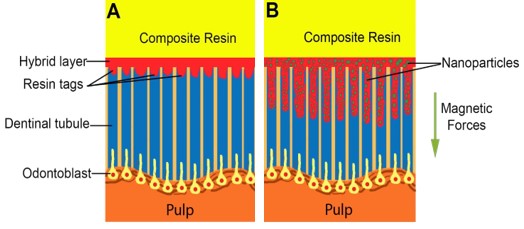Overview
University of Maryland clinical researchers saw a clear need to target therapeutic agents to dental tissues with a method that would avoid the need for an invasive procedure like a root canal. Drs. Masri and Depireux devised a platform strategy to actively deliver therapeutic payloads to the inner tooth, which relies on magnetic nanoparticles and the application of a brief magnetic force.
When the nanoparticles are included in a resin, and a magnetic force is applied, the result is deeper penetration of the adhesive into the dentinal tubules, which are the natural channels present throughout the inner tooth. Use of resin with magnetic nanoparticles results in an improved cavity filling with stronger adhesion due to reduced polymerization shrinkage and resin microleakage, which is expected to extend the overall lifetime of a filling by years. Local drug delivery to the dental pulp has proven a challenge due to its encasement within hard dentin and enamel. The magnetic nanoparticle active delivery system can be paired with a variety of payloads, such as an antibiotic, pain medication, or an anti- inflammatory drug, for the delivery of therapeutic agents locally to dental tissue.

Applications
Current therapeutic options to treat chronic inflammation of the tooth pulp are limited, outdated, and typically result in root canal treatment, and pain relief is often limited to systemic treatments. The iron nanoparticle resin technology addresses a dental market need for an effective, noninvasive method to deliver a therapeutic drug or restorative material to the interior of the tooth in a localized and controlled manner.
Pulp inflammation (pulpitis) and accompanying pain resulting from dental cavities are a global health problem affecting billions of people worldwide. The current and most common method for the treatment of pulpitis is root canal (i.e., amputation of the nerve & pulp). An estimated 92% of adults have had dental caries in their permanent teeth, which are typically treated with either silver or resin fillings. The preferred aesthetic resin filling lasts only about five years due to poor bonding to dentin, shrinkage, and microleakage. In 2016, 100M adults had composite restorations in the US. Approximately 50% to 70% of composites in the US are replaced often, at an annual cost of $5B.
Advantages
- Platform dental technology
- Efficient delivery system
- Biocompatible materials
- Proof-of-concept established for restorative & therapeutic applications
Stage of Development
Proof of concept data include both in vivo and ex vivo testing, and a prototype magnetic array is available for a planned clinical trial. In a rat model of caries, animals treated with steroid-eluting nanoparticles and magnetic force (versus controls without magnet), showed reduced levels of inflammatory cytokines and reduced tissue damage. In studies with extracted human teeth, magnetic nanoparticles paired with resin (with optimal particle size and magnetic force applied) resulted in a composite with significantly better shear bond strength.
Licensing Potential
Available for licensing and sponsored research
Contact Info
Office of Technology Transfer
620 W Lexington St., 4th Floor
Baltimore, MD 21201
Email: [email protected]
Phone: (410) 706-2380